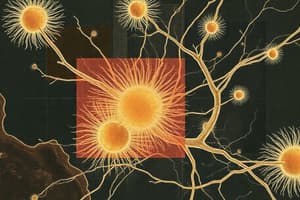Podcast
Questions and Answers
Which type of cartilage is an intermediate between hyaline and elastic cartilage?
Which type of cartilage is an intermediate between hyaline and elastic cartilage?
- Perichondrium
- Hyaline cartilage
- Elastic cartilage
- Fibrocartilage (correct)
Where is fibrocartilage commonly found in the body?
Where is fibrocartilage commonly found in the body?
- Eyeballs
- Earlobes
- Menisci of knee (correct)
- Nose
What is the primary function of cartilage in the body?
What is the primary function of cartilage in the body?
- To provide structure and support to other body tissues (correct)
- To facilitate vision
- To produce hormones
- To provide energy storage
Which type of collagen fibers are mostly found in the extracellular matrix of cartilage?
Which type of collagen fibers are mostly found in the extracellular matrix of cartilage?
Which type of cartilage provides cushioning to articulations (joints)?
Which type of cartilage provides cushioning to articulations (joints)?
What is the growth process called when chondrocytes within cartilage divide and secrete new matrix?
What is the growth process called when chondrocytes within cartilage divide and secrete new matrix?
What is the most abundant type of cartilage?
What is the most abundant type of cartilage?
Where is elastic cartilage primarily located?
Where is elastic cartilage primarily located?
Which type of cartilage contains collagen as the only type of fiber in its matrix?
Which type of cartilage contains collagen as the only type of fiber in its matrix?
Which type of cartilage is able to resist outward pressure due to the presence of perichondrium?
Which type of cartilage is able to resist outward pressure due to the presence of perichondrium?
What is the main function of fibrocartilage in the body?
What is the main function of fibrocartilage in the body?
What feature distinguishes elastic cartilage from other types of cartilage?
What feature distinguishes elastic cartilage from other types of cartilage?
What is the main function of osteocytes in bone tissue?
What is the main function of osteocytes in bone tissue?
Which cell type is responsible for the resorption of bone?
Which cell type is responsible for the resorption of bone?
Which type of bone is characterized by a dense outer layer?
Which type of bone is characterized by a dense outer layer?
In which part of the body can osteoprogenitor cells be found?
In which part of the body can osteoprogenitor cells be found?
What is the main component responsible for the compressional strength of bones?
What is the main component responsible for the compressional strength of bones?
Which bone cell type synthesizes collagen and ground substance during bone formation?
Which bone cell type synthesizes collagen and ground substance during bone formation?
Where are osteoclasts derived from?
Where are osteoclasts derived from?
What is the primary function of osteoblasts?
What is the primary function of osteoblasts?
What is the role of proteoglycans in bone composition?
What is the role of proteoglycans in bone composition?
What is the primary function of osteocytes in maintaining bone health?
What is the primary function of osteocytes in maintaining bone health?
Study Notes
Cartilage Growth and Bone Functions
- Cartilage growth halts when skeletal growth is complete.
- Appositional growth occurs as chondroblasts near perichondrium produce new matrix and convert into chondrocytes.
- Functions of bone include:
- Support: Provides a rigid framework for the body.
- Movement: Skeletal muscles utilize bones as levers.
- Protection: Shields internal organs from injury.
- Storage: Acts as a reservoir for minerals and fat.
- Blood-cell formation: Hematopoiesis occurs in red bone marrow.
- Energy metabolism: Osteoblasts release osteocalcin involved in energy regulation.
Composition of Bone
- Bone consists of approximately 35% organic material and 65% inorganic material.
- Organic components:
- Cells and extracellular matrix (osteoid).
- Type I collagen fibers provide strength and flexibility (95% of organic matrix).
- Ground substance includes proteoglycans that support collagen fibers.
- Inorganic components:
- Hydroxyapatite (Ca10(PO4)6(OH)2) endowed with compressional strength, reinforces collagen to solidify the matrix.
Bone Cell Types and Functions
- Three key cell types in bone:
- Osteoprogenitor cells: Stem cells that can differentiate into osteoblasts, involved in fracture repair, arise from periosteum and endosteum, and have mitotic activity.
- Osteoblasts: Formative cells that synthesize and secrete bone matrix and calcium salts, undergo osteogenesis.
- Osteocytes: Mature bone cells embedded within the matrix, essential for maintaining the health of the bone matrix, reside in lacunae connected by canaliculi.
- Osteoclasts: Large multinucleate cells responsible for bone resorption, derived from hematopoietic lineage, secrete acids and enzymes for matrix dissolution, crucial in regulating calcium and phosphate levels in the body.
Types of Bone and Their Structures
- Two main types of bone:
- Compact bone: Dense outer layer providing strength, characterized by osteons as functional units.
- Spongy (cancellous) bone: Internal network with the same matrix but distinct arrangements of osteocytes and canaliculi.
Microscopic Features of Compact Bone
- Osteons are the primary structure, composed of:
- Haversian and Volkmann canals housing blood vessels.
- Osteocytes arranged within lacunae in concentric layers (lamellae) around the central (Haversian) canal.
- Canaliculi facilitate communication between osteocytes and the central canal.
Characteristic Features of Compact Bone
- Other structures include:
- Perforating (Volkmann’s) canals connecting different osteons.
- Endosteum lining the bony canals and covering trabecular surfaces.
- Sharpey's fibers: Collagen fibers anchoring the periosteum to the bone.
Features of Spongy Bone
- Spongy bone characteristics:
- Comprises lamellae arranged in a trabecular, branch-like network.
- Osteocytes located in lacunae, with canaliculi extending from these lacunae.
- Contains numerous marrow cavities/spaces filled with red (hematopoietic cells) and yellow (adipocytes) marrow.
Studying That Suits You
Use AI to generate personalized quizzes and flashcards to suit your learning preferences.
Description
Test your knowledge on fibrocartilage, its structure, functions, and locations within the body. Learn about its role in providing structure, support, and cushioning in joints. Identify key components like chondrocytes, elastic fibers, and ground substance.




